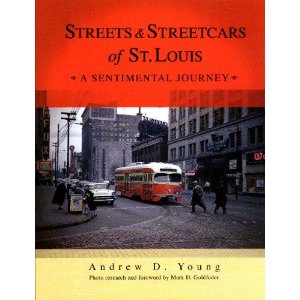 A couple of weeks ago, I shared with you news of Andrew D. Young’s marvelous 2002 book, Streets and Streetcars of St. Louis: A Sentimental Journey. I described all the great things you’ll find in the book – but thought you might also like to learn about the history of the streetcars Young shares in the book. And remember: if you’re interested in owning a personal copy of the book, you can enter my current contest. Simply go to the “Do You Remember?” post (April 4), submit a comment, and your name will be entered into the drawing. The contest ends Saturday, April 30 – and the winner will be announced on Monday, May 2.
A couple of weeks ago, I shared with you news of Andrew D. Young’s marvelous 2002 book, Streets and Streetcars of St. Louis: A Sentimental Journey. I described all the great things you’ll find in the book – but thought you might also like to learn about the history of the streetcars Young shares in the book. And remember: if you’re interested in owning a personal copy of the book, you can enter my current contest. Simply go to the “Do You Remember?” post (April 4), submit a comment, and your name will be entered into the drawing. The contest ends Saturday, April 30 – and the winner will be announced on Monday, May 2.
In the introduction to Streets and Streetcars of St. Louis, Young describes “streetcar suburbs.” “From the 1870s to the 1930s,” he writes, “streetcars were the catalyst in building and then sustaining thousands of urban neighborhoods across North America and every city had streetcar suburbs.”
Young goes on to define a streetcar suburb:
Streetcar suburbs typically are high-density mixed-use areas with single-family homes, duplexes, small and medium-sized apartment blocks and neighborhood services, focused around a rail transit line, terminal loop, stop or junction.
Young says that, although downtown St. Louis was “still the 800 pound gorilla, the magnet,” the streetcar suburbs held a special sway. Looking at the photographs of these suburbs in the 1940s, 1950s, and 1960s, the viewer sees that “their sheer liveliness is astonishing.” Young says,
Built on a scale that neither dwarfed nor crushed the human spirit, these were functional and thriving places, despite their shabby veneer. All boasted well-used local retail centers, based on corner shops, mom and pop markets, hardware, drug and package liquor stores, movie theater, the occasional Kresge’s, Woolworth’s or other generic thrift store, soda fountains, unpretentious sit-down restaurants, service stations and tire repair places. At the same time, most also had neighborhood churches, libraries, doctors, dentists, taverns, local “flea-pit” movie theater (some were better than that), parks, pool halls, schools, maybe a firehouse or police station, perhaps even an industrial area providing local employment. These social and community hubs were part of the essential urban fabric, the infrastructure around which living communities clustered, grew and thrived.
After describing the physical, community, social, and ethical space that defined the streetcar suburbs, Young then moves to a description of what has taken their place: “low-density single-family houses in the outer suburbs,” places like Chesterfield, St. Charles, and St. Peters. To help the reader understand the transition from the heyday of the streetcars to the rise of the automobile culture, Young details the rise of the St. Louis bus system into the far-flung suburbs and “the streetcar’s imminent demise.”
By 1946/1947, eight of the original streetcar lines had been removed, leaving “just over half the original streetcar system . . . operational.” By the 1950s, “a major chunk of St. Louis County once served by streetcar had no meaningful public transit of any kind.” Adding to the demise of the streetcars and the public transportation system in general, says Young, was the increasing interest in television and alternative forms of transportation: “transport-a-lift from a friend, a cab, or worst of all, their own automobile.”
From late June 1951, says Young, “the only streetcar routes left were the Hodiamont and Wellston, the Olive lines to Big Bend, Clayton (Walinca) and Delmar loops, plus the cross-town Broadway, Jefferson and Grand lines” – far fewer routes than had existed in previous decades. Those who grew up in Wellston and took the Hodiamont and Wellston lines were therefore fortunate in getting to experience the streetcars far longer than did residents in other parts of the metro area.
Though Wellstonians in the 1950s enjoyed streetcar ridership, the entire metro area suffered a “free-fall” in mass transit ridership, a decline from which it never really recovered. Despite the construction of MetroLink, St. Louisans still depend primarily on their cars – and suburbs push further and further out from the city center.
If you want to explore this fantastic book more fully on your own, consider entering the “Do You Remember?” contest. Simply go to the April 4 post, leave a comment, and you’ll be entered into the drawing for a free copy of Streets and Streetcars of St. Louis. The contest ends April 30, and I’ll be posting the collected “Do You Remember?” memories May 2.